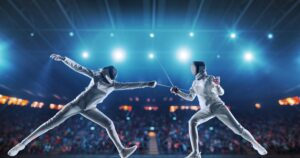Fencing
 The Basics
The Basics
Fencing is a combat Olympic sport of three disciplines— the foil, the épée, and the sabre.
Each discipline uses a different kind of weapon, has its own set of rules, and particularly, a different valid target zone on the opponent’s body for scoring.
The foil has a total length of 110cm (3.6 ft), with a maximum weight of 500g (17.6 oz). The épée has a total length of 110cm, with a maximum weight of 770g (27 oz). The sabre has a total length of 105cm (3.4 ft), with a maximum weight of 500g.
There are three 3-minute periods in a bout with the first one to score 15 touches wins.
Biomechanical shoulder forces in fencing
Fencing is a cerebral sport that demands agility, speed, and strength. The most common attack movement is the forward lunge with explosive power while simultaneously the arm thrusts forward fully in lightening speed. Although the shoulder is not as frequently injured as the knee, thigh, or ankle; the shoulder, however, is of paramount importance as the point of linkage between the forwardly moving attacking body and the tip of the striking weapon. An inadequate shoulder strength or coordination breaks this link and leads to a loss.
During the bout, the arm is constantly raised. The shoulder must bear the weight of both the raised arm plus an over 3 1/2 foot (1 meter) long weapon. The arm weighs approximately 10% of body weight with its center of mass located at a distance at about 10 times the distance of where the rotator cuff muscles insert on top of the shoulder. Therefore, in a forwardly raised arm, the leverage effect of the weight of the arm is equivalent to a constant pull of body weight force by the rotator cuff muscles in order to maintain shoulder stability. The 3 1/2 foot weapon is an extension of an approximately 2 foot (0.6 m) long arm, that weighs over one pound (500 g) in weight. The center of mass of this forwardly extended weapon is about 3 feet away from the rotator cuff muscle insertion point. This translates to an effective leverage force of over 3 ft-lb (~4 Newton-meter) by the fencer’s weapon on the rotator cuff muscles.
Rotator cuff strength
To remain competitive in fencing, the rotator cuff muscles must have the power and endurance to maintain shoulder stability and control throughout each bout. Shoulder stability is achieved by co-contraction of all 4 of the rotator cuff muscles simultaneously as one functional unit. This co-contraction creates the essential shoulder compressive force that keeps the shoulder joint centered and stable during any shoulder movement, in any direction, in any plane of motion.
ShoulderSphere technique of tight and fast rotation replicates the shoulder joint compression effect. Pulling rubber bands or lifting dumbbells are directionally based linear movements that do not specifically train this shoulder compression effect.
The training program
The accompanying video demonstrates various methods using ShoulderSphere. Fencing is a precision sport that demand power and control from the shoulder. The Power Coaching Rings seen in these videos force the user to be precise with a focused target. Training with the Coaching Rings demand focused intensity and amplifies workout load two to three fold. The height of the Coaching Rings can be set at a lower level as seen in the first technique in the video. This trains simulation lunge squats while thrusting the arm forward. Alternatively, the Coaching Rings can be set at a higher level , shoulder height, for arm motions moving forward in the front or moving on the side as in fencing arm movements.
Over a 3-minute period in fencing, the arm may be expected to be raised for a total of at least 2 minutes. Each deliberate controlled move by the arm using ShoulderSphere takes about 5 seconds; therefore, a good training routine would be making 24 passes through the Coaching Rings for a time lapse of 2 minutes. Or, another technique of just keeping the raised arm forward with sustained tight rotation using the small F2 for 2 minutes , or using the larger A7 for 30 seconds (the larger A7 being approximately six times more challenging to use than the smaller F2).
Fine point to be attentive to — the forward movement of the shoulder must terminate in full forward position with the scapula (shoulder blade) fully protracted — this is the terminal posture of athletic events that require forward accelerating thrusting movements of the arm, such as in fencing or jabs in boxing. This position using ShoulderSphere trains and strengthens the “scapulothoracic” dynamic stabilization of the shoulder joint at these end ranges of motion.
Do 3 sets to mimic the three 3-minute periods for time simulation of tournament bouts.
Disciplined use of 2-3 times per week will surely make your shoulder a strong link between your body and the tip of your weapon!